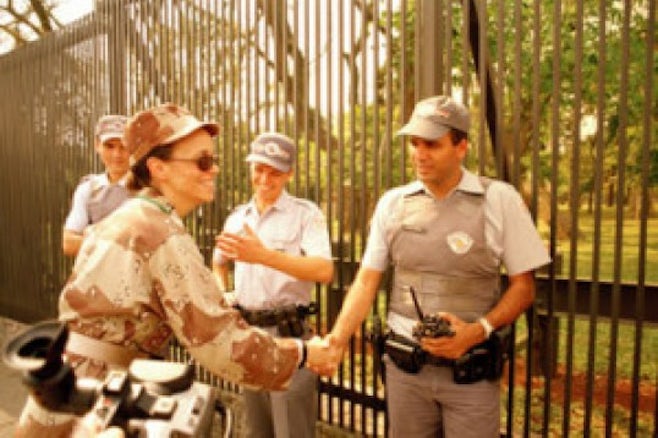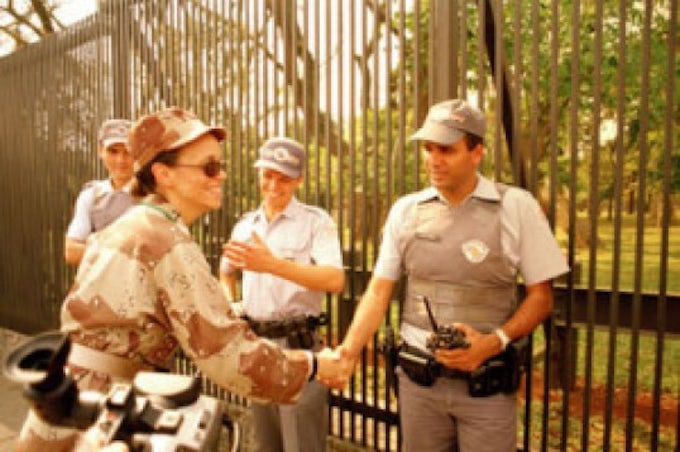
Coco Fusco’s recent exhibit at MC, Los Angeles (2006) included the photographic series Bare Life Study #1, a fictional military interrogation training manual for women, an enigmatic presentation of real manuals on a desk, and in an adjoining room, the 59-minute video Operation Atropos. The show explored the weaponization of female sexuality by the US military that was exposed by the Abu Ghraib and Guantanamo Bay prisoner abuse scandals.
The photographs that comprise Bare Life Study #1 document a 2005 performance before the gates of the US Consulate in São Paulo, Brazil. Shackled young people wearing orange inmate uniforms scrub the street with toothbrushes while Fusco, dressed in fatigues and carrying a bullhorn, assumes postures of authority over the prisoners. This work protests the human rights abuses of American detainees including the reported practice of forcing prisoners to clean the floors with their only possession, a toothbrush.
Surprisingly, information about the context of the performance is only noted in the gallery’s press release. Fusco uses the title Bare Life Study #1 to bring the photographs into an anthropological and philosophical discourse on human rights. Recently philosopher Giorgio Agamben has characterized bare life as the condition of living under a state without rights of citizenship, the condition of immigrants and prisoners. The Brazilian performance photographs become an instance of a condition, devoid of the context from which they are derived, thus, the photographs universalize the original performance. While the sight of rows of bodies submitting, on hands and knees, to a female body on a public street is a startling image of female authority, highlighting the increasing visibility of women in the current military conflict, its impact is diffused/misplaced. Without knowledge of either the alleged abuse or the performance, the work can easily be read as a role playing of dominance and submission.

The training manuals and video Operation Atropos bring up immediate associations with the American prisoner abuse scandal in Iraq. Fusco’s limited edition, the fictitious Human Resource Exploitation Manual For Female Interrogators, points to US military policies that utilize female sexuality as an interrogation tool. Each page features a briefly stated principle paired with an illustration of a female soldier interrogating a dark-skinned prisoner, presumably a Muslim. The manual is based on military practices discovered at US detention facilities and declassified CIA documents, copies of which are stacked on the desk in the corner of the gallery.
It is difficult to locate a viewpoint in the piece. The presentation is so straightforward that one cannot to say if it addresses the implications of the procedures described. At times it varies from comical, absurd, horrifying to straightforward and perhaps even cheering/approving. Somehow the combination of terse, glib text and graphic figures manages to be disappointingly uninflected. However, the illustrations of men cowering at the sight of blonde soldiers in bras also suggest a critique of the notion that Muslim men are sexually innocent and repressed and are therefore vulnerable to manipulation by Western women. The parody of this insight becomes uncomfortable when we are reminded of its implementation in physical abuses in detention centers.
Intent on researching military interrogation tactics and the use of female interrogators, last year Fusco and a group of six women enrolled in the POW Interrogation Resistance and Interrogator Training Program offered by Team Delta, a group of retired military officers. The video Fusco created from the experience follows the group in the style of a television reality show. The women submitted to a day of detention and intense questioning as a prerequisite to a second day of training in military interrogation tactics. At just under an hour, the sequences unfold in agonizingly near real-time, allowing the viewers to experience the durational stress the participants undergo. Yet I would be concerned if this controlled course were meant to illustrate a one to one correspondence with real-life detention. Here, the tactics of interrogation seem to be more about confusion, disorientation, and exhaustion with nonsensical tasks than the kinds of intense physical violence and degradation that we have seen in the media. The most uncomfortable moment here is when the camera lingers on the stripping of one of Fusco’s cadre to her underwear and she is forced to lie in the dirt. Operation Atropos alludes to both the news report from which our awareness of current events comes and the voyeurism of reality shows. This position of voyeurism reveals the viewer’s physical and political comfort and safety in relation to the participants, and beyond that, to the prisoners in Iraq and Guantanamo that they stand in for.
What is most interesting about the show is how each piece causes the viewer to question the distance between the representation and the represented. The conditions of the prison interior are always an imaginary real, one we don’t have direct access to, that is constructed by a series of media impressions, and that we ourselves navigate at our leisure. Although the work is commendable for making rarely discussed issues visible, it transplants the weaponization of female sexuality without examining the tradition of sexual manipulation as women’s primary vehicle to power. Neither does it sufficiently address the individual psychological toll paid by both soldier and prisoner.
